Welcome to our guide on how to GROW BELL PEPPER INDOORS.
You can finally enjoy fresh, delicious bell peppers all year round! Now that’s something to get excited about!
We understand how hard it is to try and grow bell peppers indoors. But it can be done with some work, patience, and love!
Wait, do you dream of having a green thumb? You should get checked out after reading the blog.
We are a team of SEASONED GARDENERS with many bell peppers! Hahaha. Whether you are a beginner or a pro looking to step up your fruit vegetables game, we want to help make it easier!
With the expertise that we have cultivated over the years, we are here to guide you every step of the way. TRUST US with your bell pepper plants! Rest assured that our team has got your back!
So let’s get started on growing those delicious bell peppers!
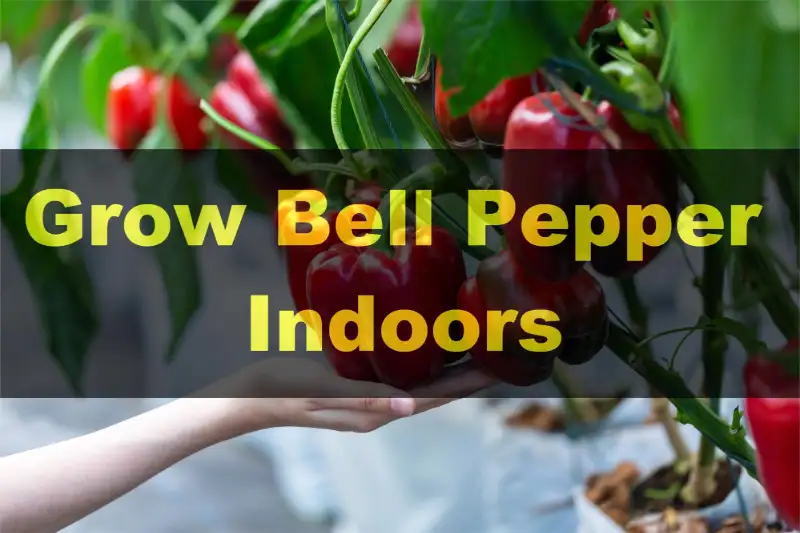
Bell Peppers: Origin and Characteristics
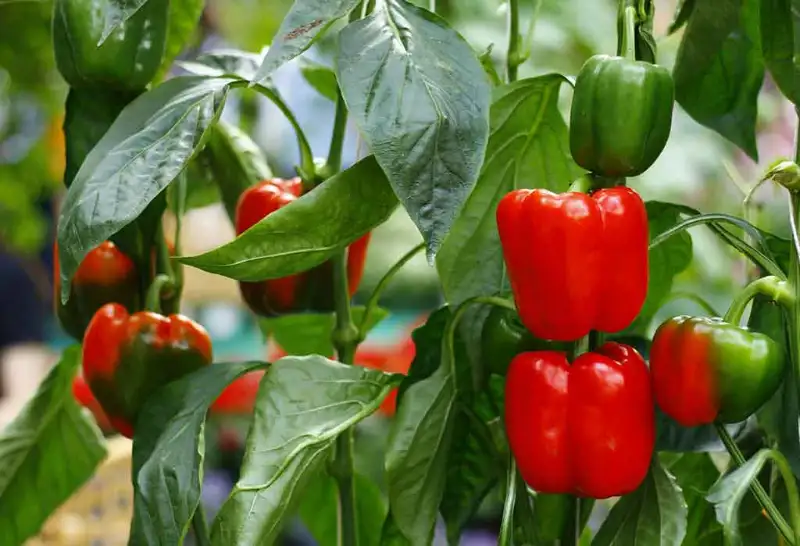
Bell peppers ORIGINATE from Central and South America, making them true Latinas! That’s why some people use them in their salsa. Hahaha. They thrive in warm climates but can also be grown in cooler climates.
Pepper plants are an excellent choice for home gardens. They are the Kim Kardashian of pepper plants. They are the MOST POPULAR PEPPER PLANT.
Bell peppers have mildly sweet and savory tastes and crunchy texture. They also come in vibrant colors ranging from RED TO YELLOW AND GREEN. It’s no wonder why they’ve become so beloved!
Are you looking to add some flavor to your dishes without sacrificing nutrition? Bell peppers are a nutritional powerhouse. They are packed with vitamins A & C. Enjoy them raw or cooked – either way, they make a delicious meal!
How to Plant Bell Peppers Indoors?

Growing bell peppers indoors can be a spicy task. Here’s a handy list of simple steps to get you started on your pepper-growing journey!
1. Choose the right type of pepper
There are many pepper varieties, so pick one that grows well indoors. Or else things could get fiery in your home! We recommend getting certified seedlings in seed trays. However, you can also get high-quality pepper seeds.
Go for PERENNIAL PLANTS, like RED BELL PEPPERS and THAI CHILIES. They are great for growing indoors. They produce fruit year after year! Just don’t expect it to come with an unlimited supply of salsa!
2. Get the right potting mix
Use well-draining soil or peat moss capability. Examples include GARDEN SOIL or POTTING MIXES specifically designed for growing peppers. Also, make sure the soil surface is rich in nutrients. It’s just like ensuring your baby plants have multivitamins down the line!
3. Find the perfect spot
Your pepper plants need plenty of natural sunlight. So, it’s best to place them near a sunny window where they can get direct sunlight for at least SIX HOURS a day. Otherwise, you might end up with glow-in-the-dark vegetables! Just kidding.
If you don’t have enough NATURAL LIGHT, consider using grow lights. They can be a good alternative light source for your peppers!
4. Select an appropriate container
Select containers large enough to accommodate growth without becoming too crowded. Think Goldilocks and her porridge bowl situation here – not too big, not too small…just right!
5 GALLONS should be good for mature plants, while 3 GALLONS are good for young ones! Any parent knows kids need room to grow! Don’t put your children in 3-gallon containers, though..just plants! Hahaha.
5. Plant your pepper seeds/seedlings
Next, fill the containers with seedlings from your seed tray. Then top off with potting soil mixed with some PEAT MOSS. Also, add water until moist but not soggy wet. This will help give your seeds the best chance at germination success rate! Please don’t make them a sad statistic! So no pressure!
6. Start Growing!
Place your trays somewhere warm (about 75°F) until sprouts appear. Then, move them to the perfect spot selected before. Or use the grow lights suggested earlier, depending on what kind of light you have available at home.
FANCY LIGHTING may not be necessary unless your plants practice their runway walk. Hahaha. Gotta keep those munchkins entertained somehow, right?
Just remember to keep rotating seedlings regularly. This will give all sides equal amounts of light exposure! No favorites here, folks.
7. Keep ’em watered!
Try to water consistently every few days. Avoid overwatering, as this can stunt their growth and cause issues like root rot later down the road. Too little water won’t do either, though. So try to find a happy medium. You can check on these precious baby pepper plants to ensure they have enough (like any parent would)!
8. Harvest time!
Watch for your fruiting pepper plants. They should reach maturity soon after. Pick whichever ones look ripe. It is time to enjoy all those red bell peppers homegrown right from home. Deliciousness awaits y’all!!!
What’s the Best Container for Indoor Pepper Plants?
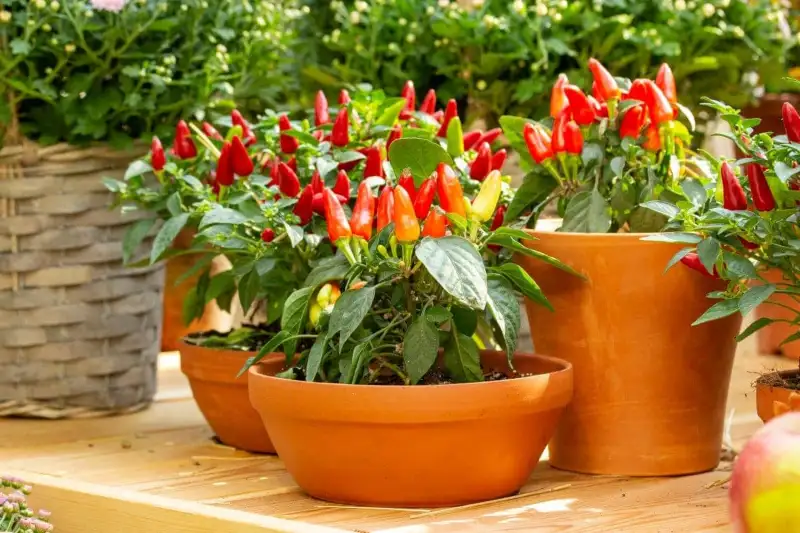
Finding the perfect container for your pepper plants is Important. It’s not easy, though. There are many things to consider. These range from pots that are too small to those that can’t contain enough potting soil.
The following are tips for finding the best container for growing peppers indoors:
1. Make sure it’s big enough to hold an entire plant and the same amount of potting soil. Go for about 6 GALLON containers. NO SKIMPING!
2. Choose a container with GOOD DRAINAGE HOLES so excess water won’t drown your plants. Otherwise, they might have no choice but to ‘swim’ away!
3. Look for something light and PORTABLE if you need to move your pepper plants around. You might need to take your plants for a walk.
4. Most importantly, make sure it’s CUTE! After all, what’s the point of having beautiful pepper plants if they’re housed in an ugly planter?
Happy planting!
Top Caring Tips for Growing Bell Peppers Indoors
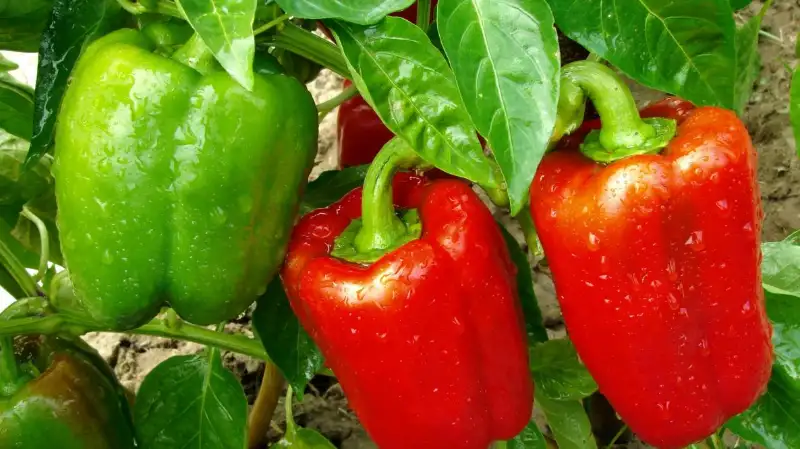
Getting the perfect harvest requires special care. Here are some tips on how you can successfully grow bell peppers indoors:
1. Get the Right Grow Lights. Peppers need INTENSE LIGHT. So, you’ll need a powerful grow light or LED lamp. This gives your peppers enough light throughout their growing season.
2. Provide Enough Space. Make sure there’s ENOUGH SPACE between each plant for good air circulation. Don’t squish your pepper plants together like a crowded subway during rush hour! This will also ensure your plants have access to natural lighting or grow lights.
3. Use a Heat Mat. Use a heat mat set at 77-82°F (25-28°C) under your plants’ potting tray or container if needed. This will help kick-start young plants or give them an extra boost of warmth IN COLD CLIMATES.
That’ll be like giving your pepper plant an extra blanket when it gets cold! So they aren’t shivering their leaves off outside in the snow!
4. Keep Humidity Moderate. Peppers LOVE MODERATE HUMIDITY and will do best with levels around 40-45%. A humidity dome helps if you want to avoid mist every few hours! Also, no one wants to be out there with water bottles spraying away to get those humidity levels up!
5. Maintain Soil Temperature. The soil should be between 70–90°F (21–32°C). Keeping it WARM is key when trying to produce fruit indoors! Just think of it as giving your peppers some cozy pajamas before bedtime every night 🙂
6. Give It Full Sun. Move pots outdoors for a few hours of direct sunlight when temperatures allow. There is no such thing as too much sun, after all. Your pepper plants need to get their vitamin D fix too!
Indoor Bell Pepper Pests and Diseases
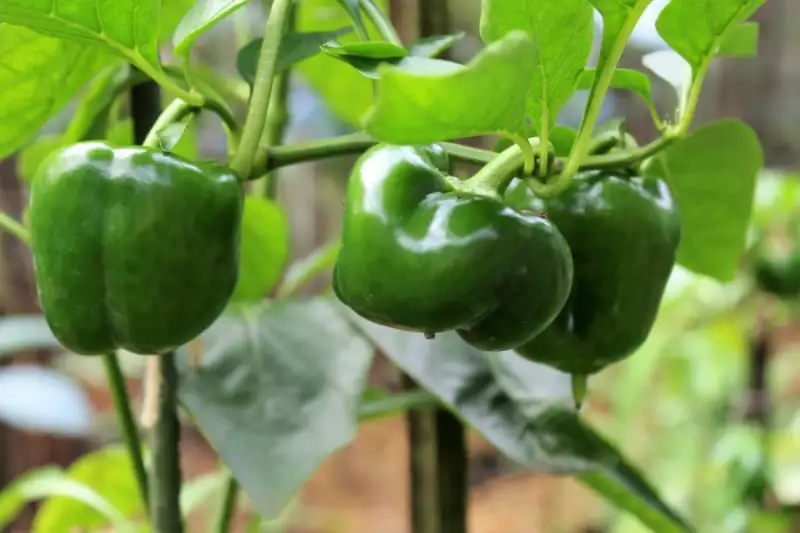
Growing bell peppers indoors can be tricky, and it’s common for them to deal with pests and diseases. Here are a few you should keep in mind.
1. Watch out for Aphids:
These tiny insects suck sap from the leaves and leave sticky residue behind. This is just like your pesky ex!
2. Look out for Whiteflies:
These annoying critters will feast on your bell pepper plants if left unchecked!
3. Beware of fungi:
Fungi can cause plant diseases like Leaf Spots. This affects the leaves and fruits of your bell pepper plants– yikes!
4. Keep an eye on caterpillars:
Caterpillars will munch away at your precious peppers without remorse!
5. Check for Mealybugs:
Mealybugs hide in the cracks and crevices of your bell peppers plants. So, make sure to do regular inspections!
6. Prevent Powdery Mildew:
Growing peppers indoors can lead to powdery mildew taking over– yikes again! Don’t fret; there are plenty of ways to beat this disease.
Harvesting and Storing Bell Peppers Indoors

So it’s time to harvest your indoor peppers! Some bell pepper varieties love the indoors and will give you a bountiful harvest. But how do you do this and store your green bell peppers?
For starters, peppers inside need to be picked when they’re still GREEN. You can leave hot peppers to ripen. This is if you want that beautiful RED or ORANGE color before harvesting.
To harvest your plants inside, TWIST EACH PEPPER off the plant, and it’s ready to be stored. If you want longer shelf life, put them in an AIRTIGHT container and pop them in the FRIDGE.
And there you have it – your own homegrown set of bell peppers! Now you can impress all your friends with your amazing harvests. Enjoy your delicious pepper varieties!
FAQs about Grow Bell Pepper Indoors
1. How long can a bell pepper plant live indoors?
A bell pepper plant can live happily indoors for years! It may even outlive you – if it’s taken care of properly. Imagine having a plant as an old friend in your home, always giving you delicious bell peppers!
You can have fresh produce at your fingertips and enjoy the beauty of a thriving plant. So don’t be afraid to give your bell pepper plant the love it needs to last for years.
2. Can I grow peppers year-round indoors?
Yes, you can grow peppers year-round indoors! These hardy plants will thrive indoors. Give them the right amount of light, water, and nutrients. You can also grow other plants alongside your peppers. This will create a beautiful and delicious indoor garden!
3. Do bell pepper plants keep producing?
Yes, bell pepper plants keep producing! You’ll have a steady supply of delicious peppers all season long. Make sure you give them plenty of sunshine and water, and they’ll reward you with tasty veggies!
4. Are bell pepper leaves edible?
Bell pepper leaves may not be something you’d consider eating, but believe it or not, they are, in fact, edible! Depending on your palate, these leaves are delicious. They mildly remind you of the bell pepper flavor but with a twist.
So why not give them a try? You never know what you might find yummy!
What’s Next
We started you off by discussing the origin and characteristics of bell peppers. Then, we explored how to plant them indoors. To accompany this, we highlighted the best container for indoor pepper plants.
Then we looked at top caring tips for growing them indoors. We also looked at indoor bell pepper pests and diseases. And lastly, we learned about harvesting and storing these crunchy delights!
Ready to get your hands dirty? Visit AsterGardening for helpful tips and tricks on your indoor bell pepper garden.
Whether you need advice on what plants to grow or how to best care for them, we’ve got you covered!
